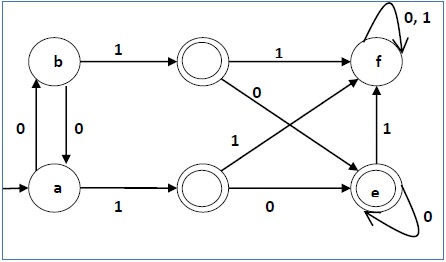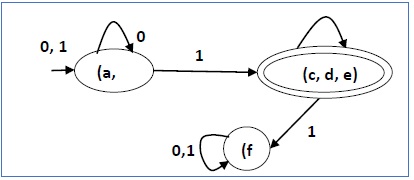MINIMIZATION OF D.F.A.
- Get link
- X
- Other Apps
There are two classes of states that can be removed or merged from the original DFA without affecting the language it accepts.
->Unreachable states are the states that are not reachable from the initial state of the DFA, for any input string. These states can be removed.->Dead states are the states from which no final state is reachable. These states can be removed unless the automaton is required to be complete.
->Nondistinguishable states are those that cannot be distinguished from one another for any input string. These states can be merged.
DFA minimization is usually done in three steps:
- remove dead and unreachable states (this will accelerate the following step),
- merge nondistinguishable states,
- optionally, re-create a single dead state ("sink" state) if the resulting DFA is required to be complete.
Step 1 − All the states Q are divided in two partitions − final states and non-final states and are denoted by P0. All the states in a partition are 0th equivalent. Take a counter k and initialize it with 0.
Step 2 − Increment k by 1. For each partition in Pk, divide the states in Pk into two partitions if they are k-distinguishable. Two states within this partition X and Y are k-distinguishable if there is an input S such that δ(X, S) and δ(Y, S) are (k-1)-distinguishable.
Step 3 − If Pk ≠ Pk-1, repeat Step 2, otherwise go to Step 4.
Step 4 − Combine kth equivalent sets and make them the new states of the reduced DFA.
Example
Let us consider the following DFA −

| q | δ(q,0) | δ(q,1) |
|---|---|---|
| a | b | c |
| b | a | d |
| c | e | f |
| d | e | f |
| e | e | f |
| f | f | f |
Let us apply the above algorithm to the above DFA −
- P0 = {(c,d,e), (a,b,f)}
- P1 = {(c,d,e), (a,b),(f)}
- P2 = {(c,d,e), (a,b),(f)}
There are three states in the reduced DFA. The reduced DFA is as follows −

| Q | δ(q,0) | δ(q,1) |
|---|---|---|
| (a, b) | (a, b) | (c,d,e) |
| (c,d,e) | (c,d,e) | (f) |
| (f) | (f) | (f) |
- Get link
- X
- Other Apps
Comments
Post a Comment